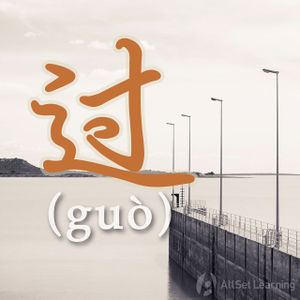Difference between revisions of "Expressing experiences with "guo""
m (Oversjw0 moved page Expressing experience with "guo" to Expressing experiences with "guo") |
|||
| Line 18: | Line 18: | ||
<div class="liju"> | <div class="liju"> | ||
| − | * 我 去 <em>过</em> 中国。 | + | * 我 去 <em>过</em> 中国。<span class="trans">I have been to China.</span> |
| − | * 他 吃 <em>过</em> 小笼包。 | + | * 他 吃 <em>过</em> 小笼包。<span class="trans">He has eaten steam dumplings.</span> |
| − | * 你 看 <em>过</em> 那 个 人 吗? | + | * 你 看 <em>过</em> 那 个 人 吗?<span class="trans">Have you seen that person?</span> |
</div> | </div> | ||
Revision as of 03:47, 28 January 2013
-
Level
-
Similar to
-
Used for
-
Keywords
The aspect particle 过 (guo) is used to indicate that an action has been experienced in the past.
Contents
Basic Pattern
Subject + Verb + 过 + Object
What this expresses is that the verb has been done at least once before, without specifying a particular time. 过 is used to talk about whether something has ever happened - whether it has been experienced.
Examples
Some examples of how 过 is typically used:
- 我 去 过 中国。I have been to China.
- 他 吃 过 小笼包。He has eaten steam dumplings.
- 你 看 过 那 个 人 吗?Have you seen that person?
Negating a 过 sentence
Because 过 is used to talk about past actions, it should be negated with 没. The structure is:
Subject + 没 + Verb + 过 + Object
Some examples:
- 我 没 去 过 中国。
- 他 没 听 过 这 首 歌。
- 你 没 尝 过 这 种 啤酒。
Using 过 with 了
You'll sometimes see 过 used together with 了. This can be a little confusing, as it doesn't seeing to be following the rules laid out above. For more on this special usage of 过, see the article on using 过 with 了.
Sources and further reading
Books
- A Practical Chinese Grammar For Foreigners (外国人实用汉语语法) (pp. 138) →buy
- Chinese: An Essential Grammar, Second Edition (pp. 59-60) →buy
- Chinese Grammar Without Tears (简明汉语语法学习手册) (pp. 73-4) →buy
- Integrated Chinese: Level 2, Part 1 (pp. 345-7) →buy
- Integrated Chinese: Level 2, Part 2 (pp. 49-51) →buy
- Modern Mandarin Chinese Grammar: A Practical Guide (pp. 76-7, 230-2) →buy
- New Practical Chinese Reader 2 (新实用汉语课本2) (pp. 175-6) →buy
Websites
- ChinesePod: Qing Wen - 过(guo) (free podcast content)



